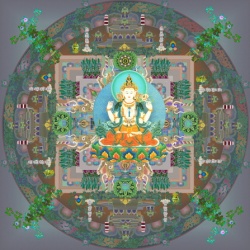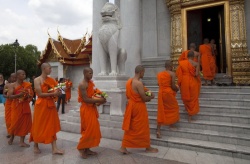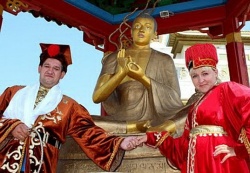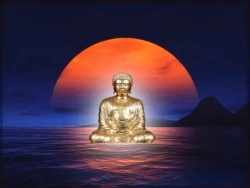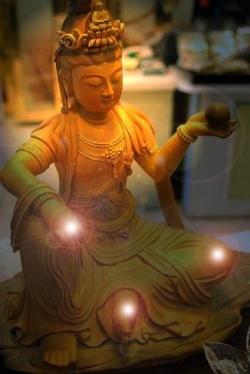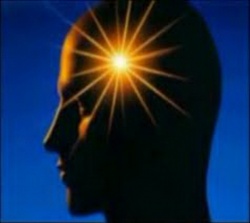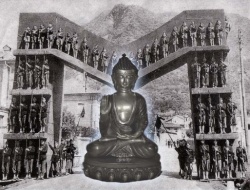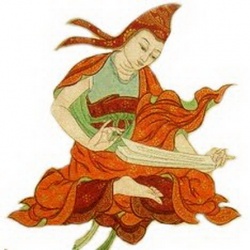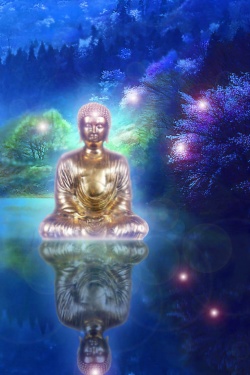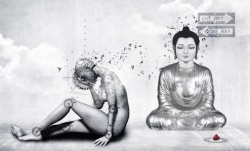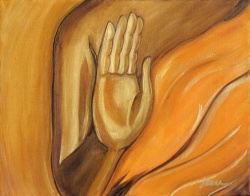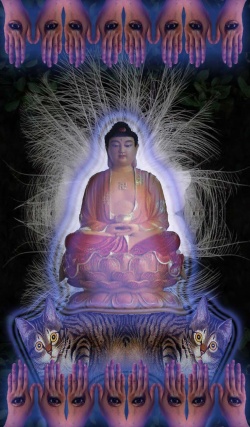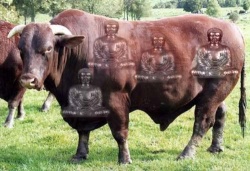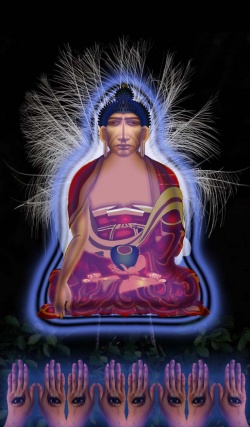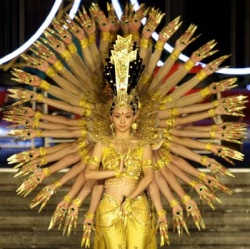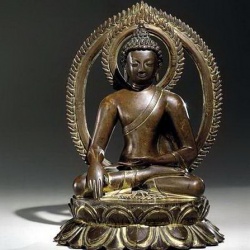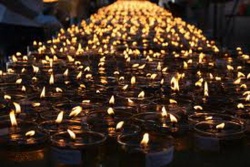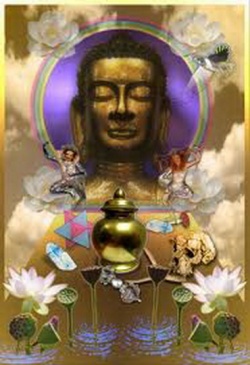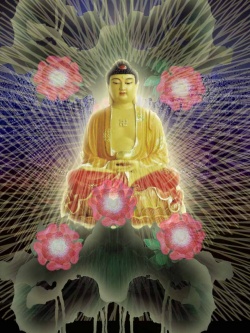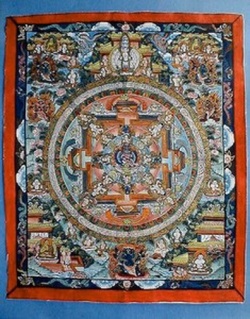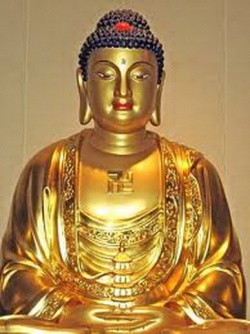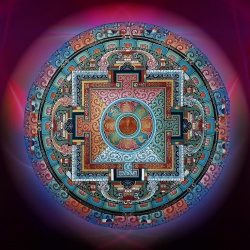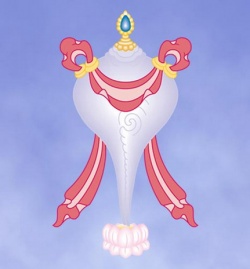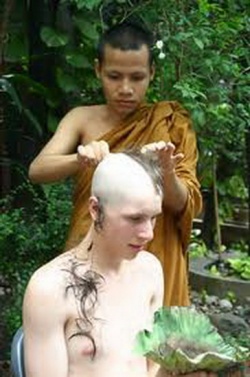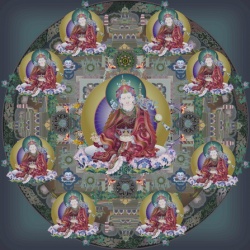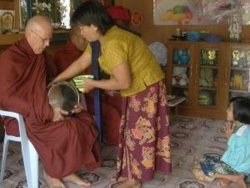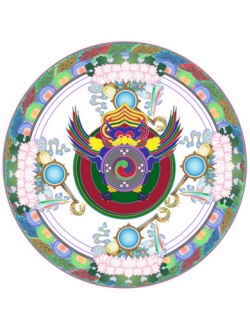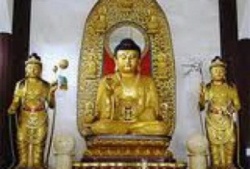Difference between revisions of "The Role of Tantra in Hinduism and Buddhism"
(Created page with " Tantra is a esoteric principle that holds an important place in both Hinduism as well as Buddhism. The word Tantra is taken from the two ...") |
|||
| Line 1: | Line 1: | ||
| + | <nomobile>{{DisplayImages|965|2523|1145|2694|3849|1281|4023|676|2061|483|4204|4300|2641|4140|2556|2258|4305|4337|992|757|321|4276|1138|3178|4227|3528|2507|2311|2625|1262|2247|1134|4261|3517|1393}}</nomobile> | ||
| Line 6: | Line 7: | ||
| + | [[Tantra]] is a [[esoteric]] [[principle]] that holds an important place in both [[Hinduism]] as well as [[Buddhism]]. The [[word]] [[Tantra]] is taken from the two [[roots]], "[[tanoti]]", to extend or stretch and "[[trayati]]", which means, [[liberation]]. | ||
| − | [[Tantra]] | + | [[Tantra]] has other connotations as well, both in the [[Hindu]] and [[Buddhist traditions]]. |
| − | + | It may apply to any of the [[scriptures]], which usually deal with the {{Wiki|worship}} of [[Goddess]] [[Shakti]], the [[Sacred]] {{Wiki|Feminine}} in the [[Hindu pantheon]]. | |
| − | According to [[Hindu]] [[tantrism]], the entire [[universe]] is considered to be the [[divine]] stage where [[Shiva]] and [[Shakti]] carry on the {{Wiki|drama}} of [[life]]. [[Tantra]] deals with [[ritual]] and [[spiritual practices]] to attain the grace of that [[Shakti]], with the aim at achieving [[liberation]] from {{Wiki|darkness}} of [[ignorance]], thus also [[attaining]] [[immortality]]. | + | According to [[Hindu]] [[tantrism]], the entire [[universe]] is considered to be the [[divine]] stage where [[Shiva]] and [[Shakti]] carry on the {{Wiki|drama}} of [[life]]. |
| + | |||
| + | [[Tantra]] deals with [[ritual]] and [[spiritual practices]] to attain the grace of that [[Shakti]], with the aim at achieving [[liberation]] from {{Wiki|darkness}} of [[ignorance]], thus also [[attaining]] [[immortality]]. | ||
| + | |||
| + | A [[practitioner of tantra]] basically believes that the [[universe]] is the concrete [[manifestation]] of the [[divine]] [[energy]] of that One Supreme Power that creates and maintains that [[universe]]. | ||
| + | |||
| + | The seeker then attempts to make himself or herself a {{Wiki|medium}} in order to [[channel]] that [[energy]], thus [[attaining]] [[liberation]] while still in [[human form]]. | ||
| − | |||
==[[Origins of Tantrism]]== | ==[[Origins of Tantrism]]== | ||
| + | |||
| Line 22: | Line 30: | ||
The spread of [[Buddhism]] to {{Wiki|East Asia}} and {{Wiki|Southeast Asia}} gave rise to the introduction and evolvement of [[tantra]] in these regions of the [[world]] as well. | The spread of [[Buddhism]] to {{Wiki|East Asia}} and {{Wiki|Southeast Asia}} gave rise to the introduction and evolvement of [[tantra]] in these regions of the [[world]] as well. | ||
| − | + | ||
| + | |||
| + | |||
| + | ==[[What Tantra actually means]]== | ||
| + | |||
| + | |||
[[Tantra]] is quite an abstract [[religion]], as in it does not have a clear [[definition]]. | [[Tantra]] is quite an abstract [[religion]], as in it does not have a clear [[definition]]. | ||
| Line 34: | Line 47: | ||
It is rather a [[tradition]] that gradually evolved from an [[accumulation]] of practices and [[rituals]], in order to attain the grace of the [[divine]]. | It is rather a [[tradition]] that gradually evolved from an [[accumulation]] of practices and [[rituals]], in order to attain the grace of the [[divine]]. | ||
| − | The [[practitioner]] of [[tantra]] uses his [[own]] [[prana]] or [[divine]] [[energy]] in order to harness it to the [[universal]] [[prana]], thereby [[attaining]] his goal. The goal in question could be either [[spiritual]], material or both. | + | The [[practitioner]] of [[tantra]] uses his [[own]] [[prana]] or [[divine]] [[energy]] in order to harness it to the [[universal]] [[prana]], thereby [[attaining]] his goal. |
| + | |||
| + | The goal in question could be either [[spiritual]], material or both. | ||
[[Tantra]] has its [[roots]] in [[mysticism]] and hence, some practitioners consider it very necessary to [[experience]] [[mystical]] [[phenomena]] during the course of their practice. Many practitioners also consider that aspirants should have the guidance of a [[guru]] or a [[spiritual master]] before entering the [[tantric]] [[realm]]. | [[Tantra]] has its [[roots]] in [[mysticism]] and hence, some practitioners consider it very necessary to [[experience]] [[mystical]] [[phenomena]] during the course of their practice. Many practitioners also consider that aspirants should have the guidance of a [[guru]] or a [[spiritual master]] before entering the [[tantric]] [[realm]]. | ||
| Line 44: | Line 59: | ||
| − | The [[Tantrik]] or the [[practitioner]] of [[Tantra]] uses various [[ritual]] tools available to him, so as to attain his goal through the practice of [[tantra]]. These include the following: | + | The [[Tantrik]] or the [[practitioner]] of [[Tantra]] uses various [[ritual]] tools available to him, so as to attain his goal through the practice of [[tantra]]. |
| + | |||
| + | |||
| + | These include the following: | ||
| + | |||
| + | <poem> | ||
| + | [[Yoga]] - | ||
| + | [[Yoga]], | ||
| + | [[asanas]] or [[yogic]] [[postures]], | ||
| + | [[meditation]] and [[pranayama]] or | ||
| + | </poem> | ||
| − | + | [[breathing]] techniques help the [[practitioner]] completely focus and [[concentrate]] on the [[divine]]. | |
[[Mantras]] - [[Mantras]] or [[chants]] help him [[visualize]] and evoke the [[divine power]], giving it [[form]] and [[potency]]. [[Mantras]] also help the follower harness the true power of [[cosmic]] {{Wiki|vibrations}}. | [[Mantras]] - [[Mantras]] or [[chants]] help him [[visualize]] and evoke the [[divine power]], giving it [[form]] and [[potency]]. [[Mantras]] also help the follower harness the true power of [[cosmic]] {{Wiki|vibrations}}. | ||
| − | Daily Mantroccharana ([[chanting]] of [[Mantras]]) helps the aspirant create a strong identification with [[deity]], so that the [[form]] becomes his "[[Ishta-Devata]]" or "prime [[meditational deity]]". | + | Daily [[Mantroccharana]] ([[chanting]] of [[Mantras]]) helps the aspirant create a strong identification with [[deity]], so that the [[form]] becomes his "[[Ishta-Devata]]" or "prime [[meditational deity]]". |
| + | |||
| − | [[Mudras]] - Tantriks believe that [[Mudras]] or gestures further enhance his attempts at [[attaining]] control over himself and over the [[mystical]] forces of [[nature]] as well. | + | [[Mudras]] - [[Tantriks]] believe that [[Mudras]] or gestures further enhance his attempts at [[attaining]] control over himself and over the [[mystical]] forces of [[nature]] as well. |
[[Mandalas]] and [[Yantras]] - [[Mandalas]] and [[Yantras]], which are various diagrammatic {{Wiki|representations}} of the forces of the [[universe]], are believed to further aid the seeker and help him achieve [[spiritual]] and [[magical powers]]. | [[Mandalas]] and [[Yantras]] - [[Mandalas]] and [[Yantras]], which are various diagrammatic {{Wiki|representations}} of the forces of the [[universe]], are believed to further aid the seeker and help him achieve [[spiritual]] and [[magical powers]]. | ||
| + | |||
==[[Tantra and the Hindu Vedic traditions]]== | ==[[Tantra and the Hindu Vedic traditions]]== | ||
| + | |||
| Line 64: | Line 92: | ||
<poem> | <poem> | ||
| − | [[Jnana]] or [[metaphysical | + | [[Jnana]] or [[metaphysical knowledge]] |
[[Yoga]] or [[meditative practices]] | [[Yoga]] or [[meditative practices]] | ||
| − | [[Kriya]] or [[ritual]] | + | [[Kriya]] or [[ritual practices]] |
[[Charya]] or [[ethical]] and [[religious]] {{Wiki|principles}} of conduct | [[Charya]] or [[ethical]] and [[religious]] {{Wiki|principles}} of conduct | ||
</poem> | </poem> | ||
| Line 73: | Line 101: | ||
Most of the staunch [[Hindu]] {{Wiki|Vedic}} practitioners, however, consider the [[Tantras]] to be anti-Vedic in [[character]] and hence, altogether [[shun]] both the {{Wiki|cult}} and the practitioners of the same. | Most of the staunch [[Hindu]] {{Wiki|Vedic}} practitioners, however, consider the [[Tantras]] to be anti-Vedic in [[character]] and hence, altogether [[shun]] both the {{Wiki|cult}} and the practitioners of the same. | ||
| − | Today, [[Tantra]] basically [[exists]] in the [[Shakta]], [[Shaiva]], [[Vaishnava]], Shaurya and [[Ganapatya]] [[traditions]]. | + | |
| + | Today, [[Tantra]] basically [[exists]] in the [[Shakta]], [[Shaiva]], [[Vaishnava]], [[Shaurya]] and [[Ganapatya]] [[traditions]]. | ||
| Line 89: | Line 118: | ||
While the other two streams help harness the [[power of mind]] by way of [[healing]] the [[spirit]], [[Tantra]] uses the power of the [[mind]] to [[balance]] the [[body]] and the [[spirit]]. | While the other two streams help harness the [[power of mind]] by way of [[healing]] the [[spirit]], [[Tantra]] uses the power of the [[mind]] to [[balance]] the [[body]] and the [[spirit]]. | ||
| − | [[Evolution]] and Involution in | + | |
| + | |||
| + | |||
| + | ==[[Evolution]] and [[Involution in Tantra]]== | ||
| + | |||
| + | |||
[[Traditionally]], the [[Tantrik]] requires to employ the three main aspects of [[Mantra]], [[Tantra]] and [[Yantra]]. | [[Traditionally]], the [[Tantrik]] requires to employ the three main aspects of [[Mantra]], [[Tantra]] and [[Yantra]]. | ||
| Line 95: | Line 129: | ||
[[Mantra]] denotes [[knowledge]], [[Tantra]] stands for [[ritual]] [[actions]] and [[Yantra]] implies the [[ethical]] code of conduct to be followed by a [[practitioner]]. | [[Mantra]] denotes [[knowledge]], [[Tantra]] stands for [[ritual]] [[actions]] and [[Yantra]] implies the [[ethical]] code of conduct to be followed by a [[practitioner]]. | ||
| − | [[Attaining]] the [[state]] of [[Sat-chit-ananda]] or "[[being-consciousness-bliss]]" is fundamental to [[Tantrism]]. This is what gives rise to [[evolution]] and also involution of the [[self]]. | + | [[Attaining]] the [[state]] of [[Sat-chit-ananda]] or "[[being-consciousness-bliss]]" is fundamental to [[Tantrism]]. |
| + | |||
| + | This is what gives rise to [[evolution]] and also involution of the [[self]]. | ||
| + | |||
| + | [[Evolution]], which can be likened to the [[external world]], defines only half the process. | ||
| + | |||
| + | |||
| − | + | Involution, which is moving internally, is what finally reveals the [[Infinite]] one to the [[devotee]]. | |
[[Tantra]] focuses on internalizing all external forces, thereby releasing or liberating the follower of [[worldly]] [[fetters]]. | [[Tantra]] focuses on internalizing all external forces, thereby releasing or liberating the follower of [[worldly]] [[fetters]]. | ||
| − | [[Rituals]] followed by Tantriks | + | [[Rituals]] followed by [[Tantriks]] |
| − | Tantriks follow very different [[ritual]] practices. | + | [[Tantriks]] follow very different [[ritual]] practices. |
| − | Because there are a variety of sects in [[Tantrism]] itself, it would become difficult to describe the practices of each one of them. Generally though, these [[rituals]] could be classified as being regular [[rituals]] and secret [[rituals]]. | + | Because there are a variety of sects in [[Tantrism]] itself, it would become difficult to describe the practices of each one of them. |
| + | |||
| + | Generally though, these [[rituals]] could be classified as being regular [[rituals]] and secret [[rituals]]. | ||
| Line 112: | Line 154: | ||
| − | The regular [[rituals]] in [[Tantrism]] include poojas or [[prayers]] being [[offered]], making use of [[Mantras]], [[Yantras]] and [[Mandalas]]. | + | The regular [[rituals]] in [[Tantrism]] include [[poojas]] or [[prayers]] being [[offered]], making use of [[Mantras]], [[Yantras]] and [[Mandalas]]. |
Both [[Hindu]] and [[Buddhist]] [[yoga]] [[traditions]] make use of these tools for [[prayers]]. | Both [[Hindu]] and [[Buddhist]] [[yoga]] [[traditions]] make use of these tools for [[prayers]]. | ||
| Line 119: | Line 161: | ||
Specific [[Yantras]] and [[Mandalas]] are used as prescribed, in order to invoke the power of these [[deities]]. | Specific [[Yantras]] and [[Mandalas]] are used as prescribed, in order to invoke the power of these [[deities]]. | ||
| + | |||
| + | |||
As [[Tantra]] mainly focuses on [[Wikipedia:Advaita Vedanta|Advaita]] ([[non-dualism]]), [[Shiva]] and [[Shakti]] are viewed as a single aspect of [[Para Shiva]] or [[Parabrahma]], the Supreme One. | As [[Tantra]] mainly focuses on [[Wikipedia:Advaita Vedanta|Advaita]] ([[non-dualism]]), [[Shiva]] and [[Shakti]] are viewed as a single aspect of [[Para Shiva]] or [[Parabrahma]], the Supreme One. | ||
| Line 143: | Line 187: | ||
| − | Since the [[Panchatattvas]] or [[five elements]] are [[vital]] to [[Tantric]] {{Wiki|worship}}, the secret [[ritual]] of [[Shakti]] and [[Shakta]] involve the {{Wiki|worship}} of the Panchamahabhutas or the [[five elements]]. | + | Since the [[Panchatattvas]] or [[five elements]] are [[vital]] to [[Tantric]] {{Wiki|worship}}, the secret [[ritual]] of [[Shakti]] and [[Shakta]] involve the {{Wiki|worship}} of the [[Panchamahabhutas]] or the [[five elements]]. |
| − | This [[Chakrapuja ritual]], as it also referred to, takes place with men and women sitting in a [[Chakra]] or circle, with the [[Shakti]] ({{Wiki|female}} [[devotee]]) sitting at the Shaktats ({{Wiki|male}} devoteets) left hand side. | + | This [[Chakrapuja ritual]], as it also referred to, takes place with men and women sitting in a [[Chakra]] or circle, with the [[Shakti]] ({{Wiki|female}} [[devotee]]) sitting at the [[Shaktats]] ({{Wiki|male}} devoteets) left hand side. |
There are various types of [[Chakrapuja]], each bestowing different kinds of benefits on the follower. | There are various types of [[Chakrapuja]], each bestowing different kinds of benefits on the follower. | ||
| Line 156: | Line 200: | ||
| − | The exact origin of [[Vamamarga]] in [[Tantrism]], which implies {{Wiki|sexual}} [[rites]], is not quite clear. But there are theories indicating that these could have been adopted from early [[Hindu Tantra]]. It was probably viewed as a {{Wiki|practical}} means of facilitating heightened states of [[awareness]], at the time. | + | The exact origin of [[Vamamarga]] in [[Tantrism]], which implies {{Wiki|sexual}} [[rites]], is not quite clear. |
| + | |||
| + | But there are theories indicating that these could have been adopted from early [[Hindu Tantra]]. It was probably viewed as a {{Wiki|practical}} means of facilitating heightened states of [[awareness]], at the time. | ||
During the course of [[meditation]], the follower would try and identify himself of herself with their [[Ishta Devata]], actually [[visualizing]] themselves as being involved in a sort of {{Wiki|sexual}} courtship with the [[deity]], finally leading to consummation of that relationship. | During the course of [[meditation]], the follower would try and identify himself of herself with their [[Ishta Devata]], actually [[visualizing]] themselves as being involved in a sort of {{Wiki|sexual}} courtship with the [[deity]], finally leading to consummation of that relationship. | ||
| − | In fact, some {{Wiki|male}} Tantriks view their {{Wiki|female}} {{Wiki|sexual}} partners as a representative of their favourite [[Goddess]]. | + | In fact, some {{Wiki|male}} [[Tantriks]] view their {{Wiki|female}} {{Wiki|sexual}} partners as a representative of their favourite [[Goddess]]. |
| Line 169: | Line 215: | ||
This would be considered as the follower's formal [[initiation]] into the {{Wiki|movement}}. | This would be considered as the follower's formal [[initiation]] into the {{Wiki|movement}}. | ||
| − | The [[Tantrik]] would also then become one of the [[Kulaputras]] (sons of the {{Wiki|clan}}), by the grace of his [[female consort]], who contains the Kulamrita ({{Wiki|clan}} [[nectar]]) or Kuladravya ({{Wiki|clan}} fluid) in her [[womb]]. | + | The [[Tantrik]] would also then become one of the [[Kulaputras]] (sons of the {{Wiki|clan}}), by the grace of his [[female consort]], who contains the [[Kulamrita]] ({{Wiki|clan}} [[nectar]]) or [[Kuladravya]] ({{Wiki|clan}} fluid) in her [[womb]]. |
| Line 182: | Line 228: | ||
According to [[Tantra]], {{Wiki|sex}} has three types of purposes - for [[pleasure]], procreation and [[liberation]]. | According to [[Tantra]], {{Wiki|sex}} has three types of purposes - for [[pleasure]], procreation and [[liberation]]. | ||
| − | Tantriks who aim at the [[highest]] {{Wiki|purpose}} of [[liberation]] endeavour to go beyond mere [[physical]] {{Wiki|orgasm}} to reach higher [[forms]] of [[ecstasy]]. | + | [[Tantriks]] who aim at the [[highest]] {{Wiki|purpose}} of [[liberation]] endeavour to go beyond mere [[physical]] {{Wiki|orgasm}} to reach higher [[forms]] of [[ecstasy]]. |
Here, the participating couple are connected [[spiritually]] to each other and often lock themselves in a long, static embrace, well after the act. | Here, the participating couple are connected [[spiritually]] to each other and often lock themselves in a long, static embrace, well after the act. | ||
In fact, [[Tantrism]] also advocates particular types of [[breathing]] during the lovemaking exercise, so that both the participants can gain the maximum [[spiritual]] [[benefit]] from the [[experience]]. | In fact, [[Tantrism]] also advocates particular types of [[breathing]] during the lovemaking exercise, so that both the participants can gain the maximum [[spiritual]] [[benefit]] from the [[experience]]. | ||
| + | |||
==[[Vamamarga]] for [[awakening the power of Kundalini]]== | ==[[Vamamarga]] for [[awakening the power of Kundalini]]== | ||
| + | |||
| Line 197: | Line 245: | ||
The act of intercourse in [[Vamamarga]] balances energies dormant within the ida and [[pingala]] naadis, [[existent]] in the [[sukshma]] [[shariras]] ([[subtle bodies]]) of both participants. | The act of intercourse in [[Vamamarga]] balances energies dormant within the ida and [[pingala]] naadis, [[existent]] in the [[sukshma]] [[shariras]] ([[subtle bodies]]) of both participants. | ||
| − | The [[sushumna]] | + | The [[sushumna nadi]] is then [[awakened]] as well, thereby giving rise to the [[awakening]] of the hitherto dormant power of the [[kundalini]], the [[Serpentine]] [[Energy]]. |
This type of [[Kundalini yoga]], which itself [[symbolizes]] the [[balance]] of the [[Shiva]] ([[Purusha]] or static) and [[Shakti]] ([[Prakriti]] or dynamic) energies within the [[body]], eventually results in its rising upwards, finally [[touching]] the [[Sahasrara Chakra]], in the devotee's {{Wiki|crown}}, thereby bestowing [[mukti]] or [[liberation]]. | This type of [[Kundalini yoga]], which itself [[symbolizes]] the [[balance]] of the [[Shiva]] ([[Purusha]] or static) and [[Shakti]] ([[Prakriti]] or dynamic) energies within the [[body]], eventually results in its rising upwards, finally [[touching]] the [[Sahasrara Chakra]], in the devotee's {{Wiki|crown}}, thereby bestowing [[mukti]] or [[liberation]]. | ||
| Line 203: | Line 251: | ||
| − | Regular practice of [[kundalini]] [[awakening]] in this fashion, it is believed, gives rise to a [[Samadhi | + | Regular practice of [[kundalini]] [[awakening]] in this fashion, it is believed, gives rise to a [[Samadhi state]], wherein both the participants dissolve completely in a {{Wiki|unity}} of [[pure]], [[cosmic consciousness]]. |
This happens even on an {{Wiki|individual}} level, where each of the participants [[experiences]] a {{Wiki|subtle}} fusion of the [[Shiva-Shakti]] energies within themselves as well. | This happens even on an {{Wiki|individual}} level, where each of the participants [[experiences]] a {{Wiki|subtle}} fusion of the [[Shiva-Shakti]] energies within themselves as well. | ||
| Line 223: | Line 271: | ||
Himself a [[practitioner]] of the [[Tantra]] [[philosophy]], [[Woodroffe]] completely understood the system with all its dynamics and was responsible for its modern-day [[evolution]]. | Himself a [[practitioner]] of the [[Tantra]] [[philosophy]], [[Woodroffe]] completely understood the system with all its dynamics and was responsible for its modern-day [[evolution]]. | ||
| − | Following in the footsteps of [[Sir John Woodroffe]], many more [[scholars]] began to delve into studying the [[Tantra]] [[philosophy]]. They finally concluded that [[Tantra]] was "the culmination of all [[Indian]] [[thought]]: | + | Following in the footsteps of [[Sir John Woodroffe]], many more [[scholars]] began to delve into studying the [[Tantra]] [[philosophy]]. |
| + | |||
| + | They finally concluded that [[Tantra]] was "the culmination of all [[Indian]] [[thought]]: | ||
the most radical [[form]] of [[spirituality]] and the {{Wiki|archaic}} [[heart]] of aboriginal [[India]]". They also considered it to be the {{Wiki|ideal}} [[religion]] of the {{Wiki|modern}} {{Wiki|era}}. | the most radical [[form]] of [[spirituality]] and the {{Wiki|archaic}} [[heart]] of aboriginal [[India]]". They also considered it to be the {{Wiki|ideal}} [[religion]] of the {{Wiki|modern}} {{Wiki|era}}. | ||
| − | [[Tantra]] eventually came to be considered as a sort of "{{Wiki|cult}} of [[ecstasy]]", combining {{Wiki|sexuality}} and [[spirituality]] in a unique way so as to offer [[complete liberation]] to the follower. This also corrected the general [[Western]] viewpoint that {{Wiki|sex}} was [[essentially]] base and only related to [[worldly]] and [[bodily]] [[pleasures]]. | + | [[Tantra]] eventually came to be considered as a sort of "{{Wiki|cult}} of [[ecstasy]]", combining {{Wiki|sexuality}} and [[spirituality]] in a unique way so as to offer [[complete liberation]] to the follower. |
| + | |||
| + | This also corrected the general [[Western]] viewpoint that {{Wiki|sex}} was [[essentially]] base and only related to [[worldly]] and [[bodily]] [[pleasures]]. | ||
| − | The most famous [[Hindu]] [[Tantric practitioners]] include [[Swami]] {{Wiki|Rama}}, Sewak Sanjaynath and Akshunnanath Mahaprabhu. | + | The most famous [[Hindu]] [[Tantric practitioners]] include [[Swami]] {{Wiki|Rama}}, [[Sewak Sanjaynath]] and [[Akshunnanath Mahaprabhu]]. |
==[[Neotantra]]== | ==[[Neotantra]]== | ||
| + | |||
Now, the term [[Tantra]] has become {{Wiki|synonymous}} with "[[spiritual]] {{Wiki|sex}}" or "[[sacred]] {{Wiki|sexuality}}" - an opinion that {{Wiki|sex}} should be [[recognized]] as a [[sacred]] act which is capable of elevating its participants to a more [[sublime]] [[spiritual state]] of being and not merely a [[physical]] act. | Now, the term [[Tantra]] has become {{Wiki|synonymous}} with "[[spiritual]] {{Wiki|sex}}" or "[[sacred]] {{Wiki|sexuality}}" - an opinion that {{Wiki|sex}} should be [[recognized]] as a [[sacred]] act which is capable of elevating its participants to a more [[sublime]] [[spiritual state]] of being and not merely a [[physical]] act. | ||
| − | The {{Wiki|concept}} of Neotantra is much like the original [[Tantra]], except that it does not follow some of the [[tenets]] of the [[latter]]. For example, Neotantra does not stipulate the presence of a [[guru]] or [[spiritual master]] to guide a follower. | + | The {{Wiki|concept}} of Neotantra is much like the original [[Tantra]], except that it does not follow some of the [[tenets]] of the [[latter]]. |
| + | |||
| + | For example, [[Neotantra]] does not stipulate the presence of a [[guru]] or [[spiritual master]] to guide a follower. | ||
Also, many of these sub-sects may not particularly advocate extensive [[meditative practice]], [[traditional]] [[ethical]] {{Wiki|rules}} of conduct and so on. | Also, many of these sub-sects may not particularly advocate extensive [[meditative practice]], [[traditional]] [[ethical]] {{Wiki|rules}} of conduct and so on. | ||
| Line 252: | Line 307: | ||
| − | [[Tantric Buddhism]], also known as [[Vajrayana Buddhism]], [[Tantrayana]], [[Mantrayana]], [[Esoteric Buddhism]] and the [[Diamond Vehicle]], is an [[ancient]] and a highly complicated system of [[Buddhist philosophy]]. [[Vajrayana]] is one of the three routes taking the follower to [[enlightenment]]. | + | |
| + | [[Tantric Buddhism]], also known as [[Vajrayana Buddhism]], [[Tantrayana]], [[Mantrayana]], [[Esoteric Buddhism]] and the [[Diamond Vehicle]], is an [[ancient]] and a highly complicated system of [[Buddhist philosophy]]. | ||
| + | |||
| + | [[Vajrayana]] is one of the three routes taking the follower to [[enlightenment]]. | ||
The other two include [[Hinayana]] and [[Mahayana]]. | The other two include [[Hinayana]] and [[Mahayana]]. | ||
| Line 263: | Line 321: | ||
[[Indrabhuti]], the [[King]] of [[Sambalpur]], was the founder of [[Vajrayana]] and his sister founded [[Sahajayana]]. | [[Indrabhuti]], the [[King]] of [[Sambalpur]], was the founder of [[Vajrayana]] and his sister founded [[Sahajayana]]. | ||
| − | These new [[emerging]] {{Wiki|cults}} also gave rise to the [[Mantra]], [[Mandala]] and [[Mudra]] aspects of [[Tantra]], as also the six main | + | These new [[emerging]] {{Wiki|cults}} also gave rise to the [[Mantra]], [[Mandala]] and [[Mudra]] aspects of [[Tantra]], as also the [[six main Tantric practices]] or [[Abhicharas]] . |
[[Vajrayana]] is complicated not only because of its {{Wiki|structure}} and {{Wiki|rules}}, but also because of the [[language]] it uses. | [[Vajrayana]] is complicated not only because of its {{Wiki|structure}} and {{Wiki|rules}}, but also because of the [[language]] it uses. | ||
| Line 269: | Line 327: | ||
[[Vajrayana]] texts employ the [[Sandhya-Bhasa,]] or a "[[twilight language]]", that was deliberately coded in order to keep it complex. | [[Vajrayana]] texts employ the [[Sandhya-Bhasa,]] or a "[[twilight language]]", that was deliberately coded in order to keep it complex. | ||
| − | This [[script]] relies on the use of | + | This [[script]] relies on the use of symbolism, {{Wiki|metaphors}}, synonyms and associated words, thereby making it very difficult to decode its many intricacies. |
This [[ancient]] [[tradition]] is now preserved mostly by [[Vajrayana]] {{Wiki|cults}} in [[Tibet]]. | This [[ancient]] [[tradition]] is now preserved mostly by [[Vajrayana]] {{Wiki|cults}} in [[Tibet]]. | ||
| − | The [[Vajra]], which means, "[[thunderbolt]]", is a legendary weapon, which was very powerful and [[indestructible]], also one which could effortlessly destroy everything in [[sight]]. Since the [[diamond]] is [[indestructible]], [[Vajrayana]] is also interpreted in English as the "[[Diamond Vehicle]]". | + | The [[Vajra]], which means, "[[thunderbolt]]", is a legendary weapon, which was very powerful and [[indestructible]], also one which could effortlessly destroy everything in [[sight]]. |
| + | |||
| + | Since the [[diamond]] is [[indestructible]], [[Vajrayana]] is also interpreted in English as the "[[Diamond Vehicle]]". | ||
The [[vajra]] is often used in [[Tantra]], in order to represent great [[bliss]], [[wisdom]] and transcending material [[existence]]. | The [[vajra]] is often used in [[Tantra]], in order to represent great [[bliss]], [[wisdom]] and transcending material [[existence]]. | ||
| Line 281: | Line 341: | ||
| − | While practitioners of [[Hindu Tantra]] are called Tantriks, the same in [[Buddhism]] are called Mantrins, [[Yogis]] or [[Sadhakas]]. | + | While practitioners of [[Hindu Tantra]] are called [[Tantriks]], the same in [[Buddhism]] are called Mantrins, [[Yogis]] or [[Sadhakas]]. |
In fact, the very term, "[[Buddhist Tantra]]", may have been borrowed from the original term, [[Tantra]]. | In fact, the very term, "[[Buddhist Tantra]]", may have been borrowed from the original term, [[Tantra]]. | ||
| Line 293: | Line 353: | ||
Secondly, [[Buddhist Tantra]] is a highly secretive practice, which stipulates strict regulations and the [[constant]] presence of a [[master]] guiding the follower. Hence, not much has been revealed about this branch of [[philosophical]] [[thought]]. | Secondly, [[Buddhist Tantra]] is a highly secretive practice, which stipulates strict regulations and the [[constant]] presence of a [[master]] guiding the follower. Hence, not much has been revealed about this branch of [[philosophical]] [[thought]]. | ||
| + | |||
==[[Origin of Vajrayana]]== | ==[[Origin of Vajrayana]]== | ||
| + | |||
| Line 305: | Line 367: | ||
[[Padmasambhava]] or [[Guru Rinpoche]] transmitted the [[Wikipedia:concept|concepts]] of [[Vajrayana Buddhism]] to the [[people]] of [[Tibet]] and [[Bhutan]] and thus to {{Wiki|mainstream}} [[Buddhism]]. | [[Padmasambhava]] or [[Guru Rinpoche]] transmitted the [[Wikipedia:concept|concepts]] of [[Vajrayana Buddhism]] to the [[people]] of [[Tibet]] and [[Bhutan]] and thus to {{Wiki|mainstream}} [[Buddhism]]. | ||
| + | |||
==[[Philosophy of Vajrayana]]== | ==[[Philosophy of Vajrayana]]== | ||
| + | |||
| Line 334: | Line 398: | ||
These [[initiation]] [[vows]] vary depending on the specific level of [[mandala]] practice required for that particular level of [[initiation]]. | These [[initiation]] [[vows]] vary depending on the specific level of [[mandala]] practice required for that particular level of [[initiation]]. | ||
| − | The [[guru]] is also expected to adhere to his or her [[own]] [[samaya vows]] all through his or her [[life]]. [[Proper conduct]] is the most important prerequisite for a qualified [[Vajrayana | + | The [[guru]] is also expected to adhere to his or her [[own]] [[samaya vows]] all through his or her [[life]]. [[Proper conduct]] is the most important prerequisite for a qualified [[Vajrayana guru]]. |
This [[esoteric]] [[philosophy]] is to be studied only under the able guidance of a [[guru]] and cannot simply be learnt from texts. | This [[esoteric]] [[philosophy]] is to be studied only under the able guidance of a [[guru]] and cannot simply be learnt from texts. | ||
| Line 351: | Line 415: | ||
There are also a few other sub-schools, which do not totally adhere to all the {{Wiki|rules}} drawn out by [[traditional]] [[Vajrayana]]. | There are also a few other sub-schools, which do not totally adhere to all the {{Wiki|rules}} drawn out by [[traditional]] [[Vajrayana]]. | ||
| + | |||
==[[Deity Yoga in Vajrayana]]== | ==[[Deity Yoga in Vajrayana]]== | ||
| + | |||
| Line 377: | Line 443: | ||
Regions where [[Vajrayana]] is still followed | Regions where [[Vajrayana]] is still followed | ||
| − | The [[philosophy]] of [[Vajrayana]] [[lives]] on and is still strong in many countries, such as [[China]], [[Tibet]], [[Japan]], {{Wiki|Indonesia}}, [[Mongolia]] and even in many regions of the [[Himalayas]]. While each one of these sects propound the main [[philosophy]] of [[Vajrayana]], they may differ slightly from each other in the way the teachings are put forth by the [[masters]] in each region. | + | The [[philosophy]] of [[Vajrayana]] [[lives]] on and is still strong in many countries, such as [[China]], [[Tibet]], [[Japan]], {{Wiki|Indonesia}}, [[Mongolia]] and even in many regions of the [[Himalayas]]. |
| + | |||
| + | While each one of these sects propound the main [[philosophy]] of [[Vajrayana]], they may differ slightly from each other in the way the teachings are put forth by the [[masters]] in each region. | ||
{{R}} | {{R}} | ||
http://www.dollsofindia.com/library/tantra/ | http://www.dollsofindia.com/library/tantra/ | ||
[[Category:Vajrayana]] | [[Category:Vajrayana]] | ||
Revision as of 17:14, 9 December 2015
Tantra is a esoteric principle that holds an important place in both Hinduism as well as Buddhism. The word Tantra is taken from the two roots, "tanoti", to extend or stretch and "trayati", which means, liberation.
Tantra has other connotations as well, both in the Hindu and Buddhist traditions.
It may apply to any of the scriptures, which usually deal with the worship of Goddess Shakti, the Sacred Feminine in the Hindu pantheon.
According to Hindu tantrism, the entire universe is considered to be the divine stage where Shiva and Shakti carry on the drama of life.
Tantra deals with ritual and spiritual practices to attain the grace of that Shakti, with the aim at achieving liberation from darkness of ignorance, thus also attaining immortality.
A practitioner of tantra basically believes that the universe is the concrete manifestation of the divine energy of that One Supreme Power that creates and maintains that universe.
The seeker then attempts to make himself or herself a medium in order to channel that energy, thus attaining liberation while still in human form.
Origins of Tantrism
It is believed that tantrism originated in the early centuries CE and gradually developed into an actual pantheon by the end of the Gupta period. It has deeply influenced the Hindu Buddhist, Jain and Sikh religions as well.
The spread of Buddhism to East Asia and Southeast Asia gave rise to the introduction and evolvement of tantra in these regions of the world as well.
What Tantra actually means
Tantra is quite an abstract religion, as in it does not have a clear definition.
Also, different seekers define the tradition in different ways, many of which are not even consistent with each other.
Tantra, though, is clearly recognized as being very different from the ancient Hindu Vedic tradition.
Before trying to delve into tantrism, it is important to understand that this is not a single coherent system.
It is rather a tradition that gradually evolved from an accumulation of practices and rituals, in order to attain the grace of the divine.
The practitioner of tantra uses his own prana or divine energy in order to harness it to the universal prana, thereby attaining his goal.
The goal in question could be either spiritual, material or both.
Tantra has its roots in mysticism and hence, some practitioners consider it very necessary to experience mystical phenomena during the course of their practice. Many practitioners also consider that aspirants should have the guidance of a guru or a spiritual master before entering the tantric realm.
Ritual tools used by a Tantrik
The Tantrik or the practitioner of Tantra uses various ritual tools available to him, so as to attain his goal through the practice of tantra.
These include the following:
breathing techniques help the practitioner completely focus and concentrate on the divine.
Mantras - Mantras or chants help him visualize and evoke the divine power, giving it form and potency. Mantras also help the follower harness the true power of cosmic vibrations.
Daily Mantroccharana (chanting of Mantras) helps the aspirant create a strong identification with deity, so that the form becomes his "Ishta-Devata" or "prime meditational deity".
Mudras - Tantriks believe that Mudras or gestures further enhance his attempts at attaining control over himself and over the mystical forces of nature as well.
Mandalas and Yantras - Mandalas and Yantras, which are various diagrammatic representations of the forces of the universe, are believed to further aid the seeker and help him achieve spiritual and magical powers.
Tantra and the Hindu Vedic traditions
Tantra in Hinduism could be considered to be parallel to the Hindu Vedic tradition. Tantra contains written records of the Agama, which comes in four main parts, as follows:
Jnana or metaphysical knowledge
Yoga or meditative practices
Kriya or ritual practices
Charya or ethical and religious principles of conduct
Most of the staunch Hindu Vedic practitioners, however, consider the Tantras to be anti-Vedic in character and hence, altogether shun both the cult and the practitioners of the same.
Today, Tantra basically exists in the Shakta, Shaiva, Vaishnava, Shaurya and Ganapatya traditions.
Though each one of these cults has their own texts and treatises, there is no clear line of demarcation between all of them and they all include the basic tenets of Tantrism.
Tantra and Yoga are essentially contrary entities.
While Tantra believes in non-dualism, Yoga propounds a dualistic philosophy of renunciation. However, these two systems do have some things in common.
The ancient Rishis or sages had broadly categorized wisdom into three streams of knowledge, namely, Ayurveda (involved with the gross physical body), Yoga (exercises for the subtle body or spirit) and Tantra (involved with mental and metaphysical abilities).
While the other two streams help harness the power of mind by way of healing the spirit, Tantra uses the power of the mind to balance the body and the spirit.
Evolution and Involution in Tantra
Traditionally, the Tantrik requires to employ the three main aspects of Mantra, Tantra and Yantra.
Mantra denotes knowledge, Tantra stands for ritual actions and Yantra implies the ethical code of conduct to be followed by a practitioner.
Attaining the state of Sat-chit-ananda or "being-consciousness-bliss" is fundamental to Tantrism.
This is what gives rise to evolution and also involution of the self.
Evolution, which can be likened to the external world, defines only half the process.
Involution, which is moving internally, is what finally reveals the Infinite one to the devotee.
Tantra focuses on internalizing all external forces, thereby releasing or liberating the follower of worldly fetters. Rituals followed by Tantriks
Tantriks follow very different ritual practices.
Because there are a variety of sects in Tantrism itself, it would become difficult to describe the practices of each one of them.
Generally though, these rituals could be classified as being regular rituals and secret rituals.
Regular Tantric rituals
The regular rituals in Tantrism include poojas or prayers being offered, making use of Mantras, Yantras and Mandalas.
Both Hindu and Buddhist yoga traditions make use of these tools for prayers.
In the Hindu tradition of Tantra, specific deities such as Shakti, Shiva and Kali are invoked during prayer.
Specific Yantras and Mandalas are used as prescribed, in order to invoke the power of these deities.
As Tantra mainly focuses on Advaita (non-dualism), Shiva and Shakti are viewed as a single aspect of Para Shiva or Parabrahma, the Supreme One.
Hence, though the followers may worship their Ishta Devata externally with flowers, incense, chants and so on, they essentially try to visualize themselves as the deity or experience the darshan of their deity.
Secret Tantric rituals
The secret aspect of Tantric rituals, also called Vamamarga, is totally removed from conventional norms of Hindu worship.
While secret rituals may also include many aspects of conventional worship, it mainly deals with sensate rites, involving all the senses.
Hence, this kind of worship would include themes such as feasting (representing sustenance); intercourse (embodying sexuality, fertility and procreation) and urination, defecation and vomiting (symbolizing removal of wastes).
Hence, Tantra involves the devotee working along with Nature and not against it.
The Panchatattva ritual
Since the Panchatattvas or five elements are vital to Tantric worship, the secret ritual of Shakti and Shakta involve the worship of the Panchamahabhutas or the five elements.
This Chakrapuja ritual, as it also referred to, takes place with men and women sitting in a Chakra or circle, with the Shakti (female devotee) sitting at the Shaktats (male devoteets) left hand side.
There are various types of Chakrapuja, each bestowing different kinds of benefits on the follower.
The Vamamarga or Sexual rites of Tantrism
The exact origin of Vamamarga in Tantrism, which implies sexual rites, is not quite clear.
But there are theories indicating that these could have been adopted from early Hindu Tantra. It was probably viewed as a practical means of facilitating heightened states of awareness, at the time.
During the course of meditation, the follower would try and identify himself of herself with their Ishta Devata, actually visualizing themselves as being involved in a sort of sexual courtship with the deity, finally leading to consummation of that relationship.
In fact, some male Tantriks view their female sexual partners as a representative of their favourite Goddess.
In yet other sects of the Vamachara type of Tantrism, sexual intercourse is viewed as a means to gain access into the underlying processes governing the functioning of this very Universe.
Some sects even performed certain initiation ceremonies involving exchange of sexual fluids between masters and their followers. Here, the emission of male and female sexual fluids would be admixed with the guru's own.
This would be considered as the follower's formal initiation into the movement.
The Tantrik would also then become one of the Kulaputras (sons of the clan), by the grace of his female consort, who contains the Kulamrita (clan nectar) or Kuladravya (clan fluid) in her womb.
Interestingly, the Vamamarga constitutes a vital aspect among certain Tantric sects.
As Tantrism evolved further, the Vamamarga approach began to focus on coital bliss as a desire for divine union - this essentially became a means to the goal of the Jivatma reaching out toward the Paramatma.
The ritual of this intercourse finally culminates in a sublime experience of infinite awareness for both the participants involved in this rite.
According to Tantra, sex has three types of purposes - for pleasure, procreation and liberation.
Tantriks who aim at the highest purpose of liberation endeavour to go beyond mere physical orgasm to reach higher forms of ecstasy.
Here, the participating couple are connected spiritually to each other and often lock themselves in a long, static embrace, well after the act.
In fact, Tantrism also advocates particular types of breathing during the lovemaking exercise, so that both the participants can gain the maximum spiritual benefit from the experience.
Vamamarga for awakening the power of Kundalini
The Vamamarga involves elaborate rites for purification.
The act of intercourse in Vamamarga balances energies dormant within the ida and pingala naadis, existent in the sukshma shariras (subtle bodies) of both participants.
The sushumna nadi is then awakened as well, thereby giving rise to the awakening of the hitherto dormant power of the kundalini, the Serpentine Energy.
This type of Kundalini yoga, which itself symbolizes the balance of the Shiva (Purusha or static) and Shakti (Prakriti or dynamic) energies within the body, eventually results in its rising upwards, finally touching the Sahasrara Chakra, in the devotee's crown, thereby bestowing mukti or liberation.
Regular practice of kundalini awakening in this fashion, it is believed, gives rise to a Samadhi state, wherein both the participants dissolve completely in a unity of pure, cosmic consciousness.
This happens even on an individual level, where each of the participants experiences a subtle fusion of the Shiva-Shakti energies within themselves as well.
Interestingly, this form of worship can also be seen in certain minor sects and movements in the West.
Modern view of Tantrism
Sir John Woodroffe was the first ever Western scholar to take the study of Tantra in detail.
He is considered as the "founding father of Tantric studies". Woodroffe, who actively propagated Tantrism, also defended Tantra against its several critics.
He was also responsible for presenting Tantra as an ethical philosophical system, which was also complimentary to the much-prevalent Vedic system.
Himself a practitioner of the Tantra philosophy, Woodroffe completely understood the system with all its dynamics and was responsible for its modern-day evolution.
Following in the footsteps of Sir John Woodroffe, many more scholars began to delve into studying the Tantra philosophy.
They finally concluded that Tantra was "the culmination of all Indian thought:
the most radical form of spirituality and the archaic heart of aboriginal India". They also considered it to be the ideal religion of the modern era.
Tantra eventually came to be considered as a sort of "cult of ecstasy", combining sexuality and spirituality in a unique way so as to offer complete liberation to the follower.
This also corrected the general Western viewpoint that sex was essentially base and only related to worldly and bodily pleasures.
The most famous Hindu Tantric practitioners include Swami Rama, Sewak Sanjaynath and Akshunnanath Mahaprabhu.
Neotantra
Now, the term Tantra has become synonymous with "spiritual sex" or "sacred sexuality" - an opinion that sex should be recognized as a sacred act which is capable of elevating its participants to a more sublime spiritual state of being and not merely a physical act.
The concept of Neotantra is much like the original Tantra, except that it does not follow some of the tenets of the latter.
For example, Neotantra does not stipulate the presence of a guru or spiritual master to guide a follower.
Also, many of these sub-sects may not particularly advocate extensive meditative practice, traditional ethical rules of conduct and so on.
This type of tantra, though, goes against the very grain of the originally stipulated Tantric path and essentially creates misunderstanding and confusion among followers, finally leading them towards basal desires and the fulfilment of mere orgasmic pleasures.
Tantra in Buddhism
Vajrayana Buddhism
Tantric Buddhism, also known as Vajrayana Buddhism, Tantrayana, Mantrayana, Esoteric Buddhism and the Diamond Vehicle, is an ancient and a highly complicated system of Buddhist philosophy.
Vajrayana is one of the three routes taking the follower to enlightenment.
The other two include Hinayana and Mahayana.
What sets Buddhist Tantrism apart from all the other sects are the rituals, which use the Upaya (or skilful) aspect to attain Godhead, rather than mere meditation.
Vajrayana Buddhism appeared in India around the 3rd Century and continued till the 12th Century.
Indrabhuti, the King of Sambalpur, was the founder of Vajrayana and his sister founded Sahajayana.
These new emerging cults also gave rise to the Mantra, Mandala and Mudra aspects of Tantra, as also the six main Tantric practices or Abhicharas .
Vajrayana is complicated not only because of its structure and rules, but also because of the language it uses.
Vajrayana texts employ the Sandhya-Bhasa, or a "twilight language", that was deliberately coded in order to keep it complex.
This script relies on the use of symbolism, metaphors, synonyms and associated words, thereby making it very difficult to decode its many intricacies.
This ancient tradition is now preserved mostly by Vajrayana cults in Tibet.
The Vajra, which means, "thunderbolt", is a legendary weapon, which was very powerful and indestructible, also one which could effortlessly destroy everything in sight.
Since the diamond is indestructible, Vajrayana is also interpreted in English as the "Diamond Vehicle".
The vajra is often used in Tantra, in order to represent great bliss, wisdom and transcending material existence.
It is important to understand here that Buddhist Tantra is not very much related to the traditional Hindu Tantra, though both types of Tantra had quite a few aspects in common.
While practitioners of Hindu Tantra are called Tantriks, the same in Buddhism are called Mantrins, Yogis or Sadhakas.
In fact, the very term, "Buddhist Tantra", may have been borrowed from the original term, Tantra. Difficulties in studying Buddhist Tantra
While decoding the texts of Vajrayana is difficult enough, the whole endeavour becomes even more complex because none of these texts offer a systematized order.
The Vajrayana texts, which may total up to about two thousand in number, are not well-ordered and follow a strange system of coding much of the way.
Vajrayana branched mainly from Hinduism and hence, the rituals need to be analyzed more before embarking on a research on the subject.
Secondly, Buddhist Tantra is a highly secretive practice, which stipulates strict regulations and the constant presence of a master guiding the follower. Hence, not much has been revealed about this branch of philosophical thought.
Origin of Vajrayana
The Vajrayana states that the Buddha himself had expounded these teachings, 16 years after his enlightenment.
But the literature of the Vajrayana is not at all mentioned in either the Pali Canon or the Agamas, the oldest treatises of Buddhism.
Hence, one cannot associate this cult with the original Buddhist philosophy.
Padmasambhava or Guru Rinpoche transmitted the concepts of Vajrayana Buddhism to the people of Tibet and Bhutan and thus to mainstream Buddhism.
Philosophy of Vajrayana
Vajrayana mainly aims at making the follower experience the true Buddha-nature, before actually achieving enlightenment.
Vajrayana makes the premise that we all innately possess an enlightened mind, without actually realizing it.
The practice of this discipline, the philosophy states, opens up our eyes to this ultimate truth, thereby awakening the Buddha-nature lying dormant within all of us.
All practices prescribed by Vajrayana seek to eventually purify the follower, eventually creating a state of enlightenment in him or her.
These means of purification can range from simple meditational practices to more complicated methods of tantric sadhana.
As an esoteric discipline, Vajrayana stipulates that the seeker undergoes ritual initiation under a skilled Guru or master.
Vajrayana also propounds that all followers should undertake this practice only in order to achieve Buddhahood, so as to use it for the benefit of all mankind.
Code of conduct in Vajrayana
Practitioners of Vajrayana require to adhere to various tantric codes of conduct, also called "samaya".
These initiation vows vary depending on the specific level of mandala practice required for that particular level of initiation.
The guru is also expected to adhere to his or her own samaya vows all through his or her life. Proper conduct is the most important prerequisite for a qualified Vajrayana guru.
This esoteric philosophy is to be studied only under the able guidance of a guru and cannot simply be learnt from texts.
It is believed that if the student does not practice these techniques properly, he may actually end up harming himself mentally or physically or both.
The samaya, which gives rise to the student-teacher bonding, protects both the preceptor and the student from its harmful side-effects.
Schools of Vajrayana Buddhism
Today, Vajrayana Buddhism mainly exists in the form of the two major sub-schools of Tibetan Buddhism and Shingon Buddhism.
There are also a few other sub-schools, which do not totally adhere to all the rules drawn out by traditional Vajrayana.
Deity Yoga in Vajrayana
Deity yoga is vital to Vajrayana practice. Here, practitioners visualize themselves as the meditation Buddha or Yidam.
The purpose of this idol worship is to make the follower understand the concept of non-duality.
The seeker can also use several other ritual tools such as a vajra, bell, damaru (hand-drum) or a phurba (ritual dagger). He can even employ ritual mudras, chant special mantras and so on.
Each of these tools contain a symbolic meaning which help create a suitable prayerful environment for the devotee to attain his ultimate goal of enlightenment.
Interestingly, this aspect of using symbolisms in Vajrayana has acted as a major source of inspiration for traditional Tibetan art.
The Death Yoga
The Death Yoga, which is an important part of Vajrayana, is actually practiced by the follower when he or she is alive, prepares him or her for the ultimate reality of death of the physical body.
During death, the mind is empty and hence, can be easily opened to enlightenment if practiced upon skillfully enough. Regions where Vajrayana is still followed
The philosophy of Vajrayana lives on and is still strong in many countries, such as China, Tibet, Japan, Indonesia, Mongolia and even in many regions of the Himalayas.
While each one of these sects propound the main philosophy of Vajrayana, they may differ slightly from each other in the way the teachings are put forth by the masters in each region.
